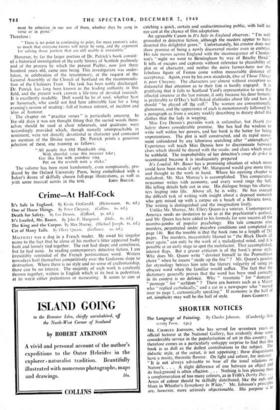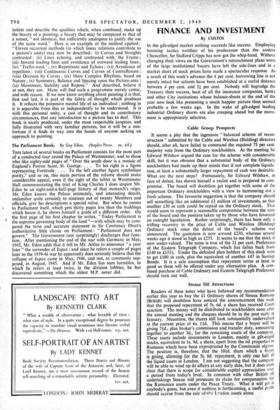SHORTER NOTICES
I lie Language of Painting. By Charles Johnson. (Cambridge Uni-
versity Press. 2 SS.) MR- CHARLES JOHNSON, who has served for seventeen years a+ official lecturer at the National Gallery, has evidently done some considerable service in the popularisation of art in this country. It therefore comes as a particularly unhappy surprise to find that this book is as dull as the dullest contributions to the subject. The didactic style, at the outset, is not appetising ; these disquisition' have a musty, theoretic flavour. On light and colour, for instance: " It is not always advisable to base all the tonal relations on Nature's. . . . A slight difference of one between an object and its background is often effective.... Nothing is less pleasing than a conglomeration of too many colours, as in Frith's Derby Day.. • • Areas of colour should be skilfully distributed, like the reds and blues in Whistler's Symphony in White." Mr. Johnson's principles are, however. more seriously objectionable. His purpose is 1°
isolate and describe the qualities which, when combined, make up the beauty of a painting, a beauty that may be compared to that of a sunset, " not identical, but sufficiently analogous to justify the use of the same word." Here is an example of the method applied: " Eleven recurrent methods (in which linear relations contribute to a picture's unity) may now be described: (i) Curves and Straights contrasted ; (ii) Lines echoing, and contrasted with, the Frame ; (iii) Inward leading lines and avoidance of outward leading lines ; (iv) ' Trellis-work ' ; (v) Repetitions and Echoes ; (vi) Avoidance of repetition ; (vii) Continuous Curves and Curves of Contraflexure ; (viii) Division by Curves ; (ix) More Complex Rhythms, based on Nature ; (x) Symmetry, Balance and Spacing upon the Picture-area ; (xi) Movement, Stability and Repose." And described, believe it or not, they are. Many will find such a programme merely comic, and with reason. If we now know anything about painting it is that, first and last, it is part of the fabric of thought which produces it. It reflects the purposive mental life of an individual ; nothing in it is separable from this or independently to be understood. It is with this personal unity, a cast of thought and its contributory circumstances, that any introduction to a picture has to deal. This book is nicely produced, under the most respectable auspices, and fully illustrated with very familiar pictures, but it will be a mis- fortune if it finds its way into the hands of anyone seeking an approach to painting.



































 Previous page
Previous page